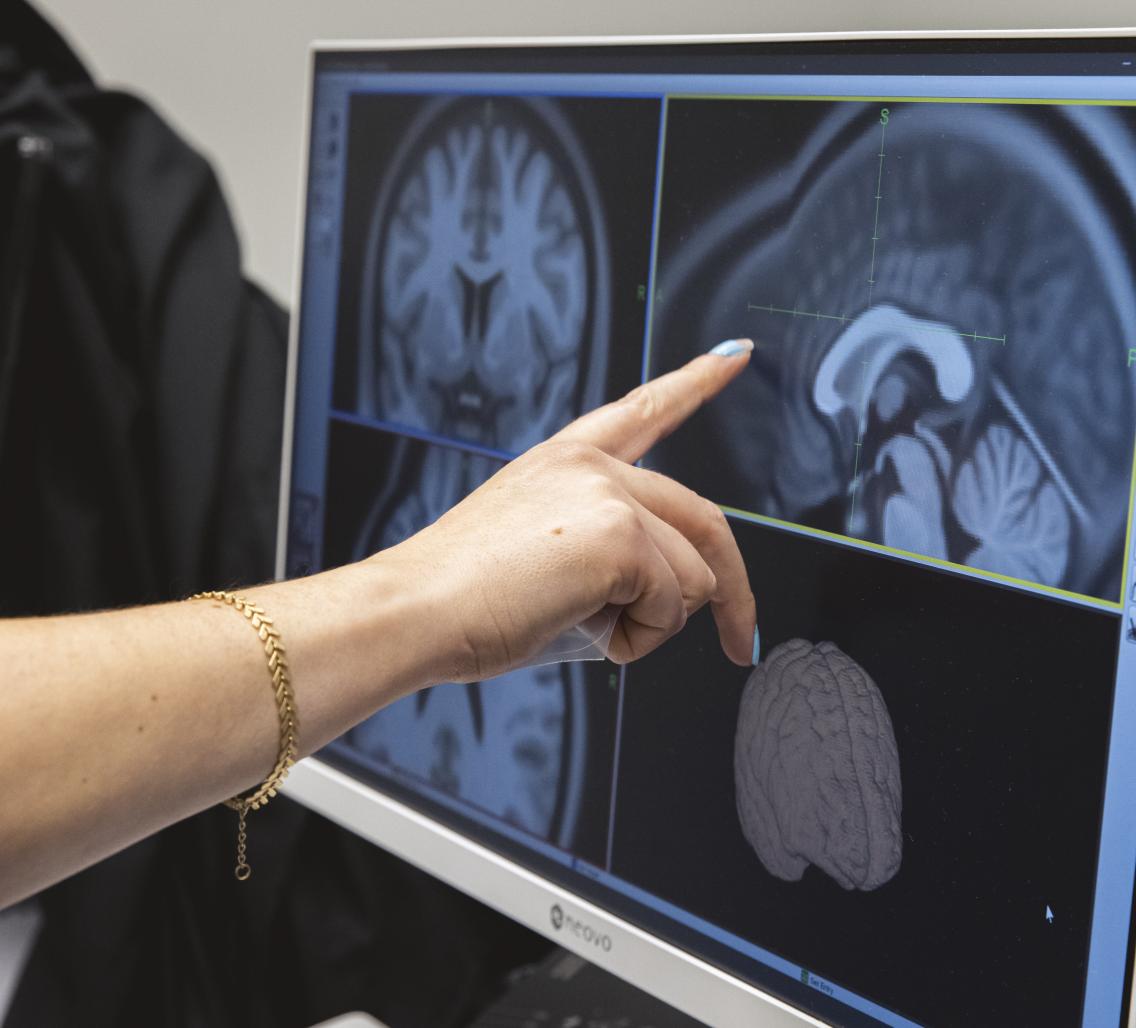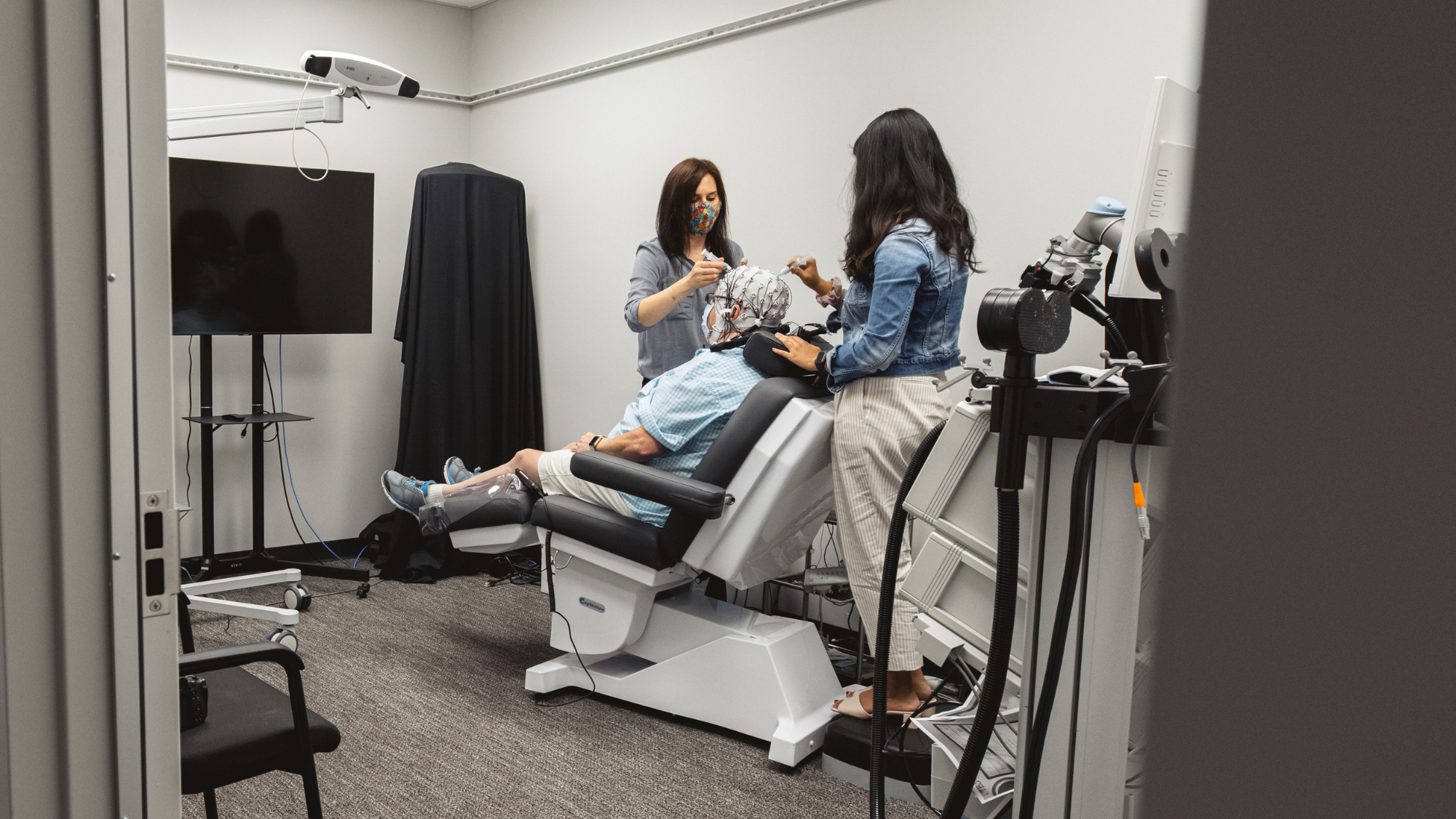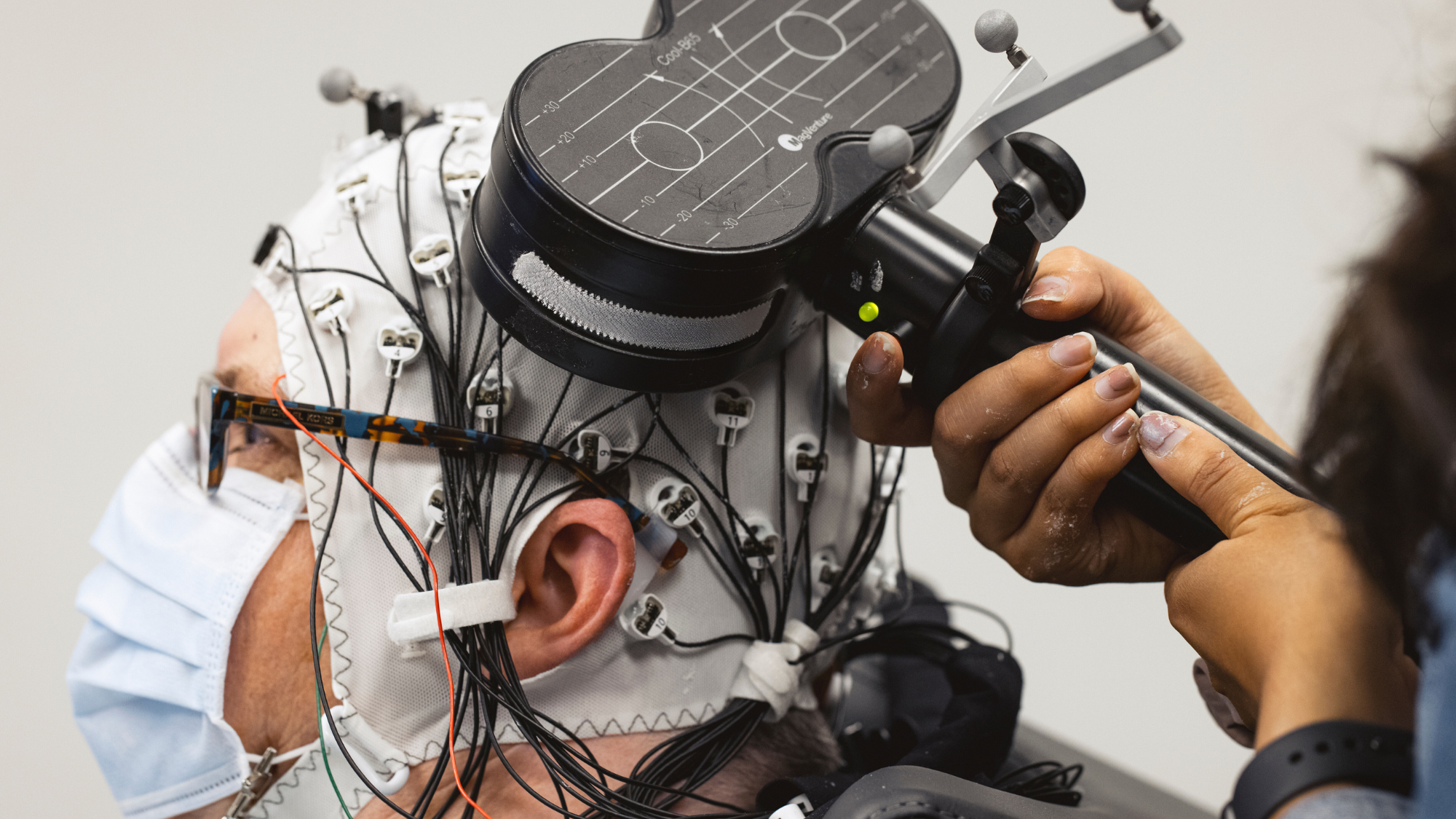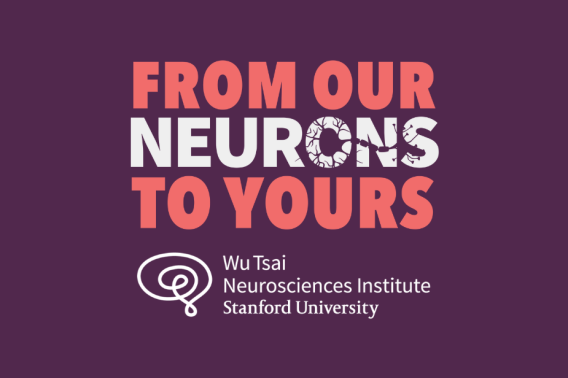Koret Human Neurosciences Community Lab Announces Inaugural Pilot Grant Awards

High-density electroencephalography (EEG) and transcranial magnetic stimulation (TMS) are revolutionizing our understanding of the brain. EEG measures complex patterns of electrical activity on the scalp caused by underlying neuronal activity, enabling researchers to make inferences about neural dynamics during various cognitive tasks. On the other hand, TMS uses powerful magnetic pulses to stimulate focal parts of the brain, allowing us to explore brain-behavior relationships and treat neurological disorders.
Located within the Stanford Neurosciences Building, the Koret Human Neurosciences Community Lab provides state-of-the-art EEG and TMS technologies alongside expert guidance to researchers across disciplines, promoting innovative research and collaboration. To increase accessibility of these advanced technologies to scientists of all disciplines and career levels, the Institute created the Human Neuroscience Pilot Grants.
“The pilot grants are a wonderful opportunity to explore the potential of EEG or TMS,” said Milena Kaestner, director of the Koret Human Neurosciences Community Lab. “These grants will enable scientists across campus to develop new skills and push their research in exciting new directions.”
The Koret Human Neurosciences Community Lab has awarded its inaugural Human Neuroscience Pilot Grants. These grants support ten innovative research projects, including EEG integration for architectural design, the neural dynamics of dyslexia, cognitive training markers in mild cognitive impairment, and brain-based markers for managing chronic pain and alcohol use. Each project represents a step forward in leveraging EEG and TMS technologies to push the boundaries of our understanding of the brain.
Awardee Alberto Tono, a PhD student in Civil and Environmental Engineering and HAI Graduate Fellow, expressed his excitement about exploring intelligence augmentation (IA)—leveraging machines to enhance human intelligence—within the architectural, engineering, and construction (AEC) industry with his grant. “Our research focuses on augmenting cognitive processes in design tasks to ensure comprehensive consideration of key aspects such as cost, sustainability, constructability, and 3D layout during the initial design stages,” Tono explained. “Thanks to the Koret Pilot Grant, we will integrate a 128-channel EEG with immersive reality technologies and deep learning methods to deepen our understanding of the cognitive processes in real-time design workflows. This grant will allow us to provide a more human-centric quantitative approach to the emerging field of Design Neurocognition.”
Fiona Baumer, Assistant Professor of Pediatric Neurology and awardee, highlighted the importance of access to the Koret Lab’s advanced equipment. “We are thrilled to have access to the state-of-the-art equipment at Koret,” she said. “This support makes it possible to study the causal relationships between connectivity and cognition in children with epilepsy in a rigorous and non-invasive way.”
Ariel Chan, an IDEAL Provostial Fellow in Linguistics, shared her enthusiasm for the interdisciplinary potential of her awarded project. "We are extremely excited about our project, as it holds the promise to uncover how social contexts and language experience influence bilingual language processes in the brain,” Chan shared. “It also provides an invaluable opportunity for us to cultivate interdisciplinary research that integrates methods traditionally used in other disciplines.”
Jessica Ross, a Postdoctoral Scholar in the Precision Neurotherapeutics Lab, emphasized the significance of the grant in exploring innovative treatments. “The future of TMS requires a better understanding and use of brain state dependencies to guide the next stage of innovative treatments in the field,” Ross noted. A brain state is a configuration of brain activity that reflects a person's current state, encompassing everything from memories and emotions to knowledge and skills at a given moment. This state can change in response to different stimuli or conditions, making it crucial for understanding and developing new treatments. “The Koret Pilot Grant is enabling us to explore brain state effects using music while developing a novel protocol for TMS that leverages brain state,” she added.
“I am excited to work with investigators across many disciplines, and to support where needed via training sessions or consultation on study design and data analysis,” said Kaestner. “It’s been great to see such diverse projects come to life—particularly when working with teams who haven’t used these technologies before!”
Funded Projects
EEG-based Projects
Biomarkers of awareness and response to treatment in obsessive-compulsive disorder (BARTOC): Implementing EEG-based biomarkers of cognitive control in a pilot study of nitrous oxide inhalation vs placebo in OCD
- Peter van Roessel, Clinical Associate Professor, Psychiatry and Behavioral Sciences
This project is focused on developing EEG-based measures of cognitive control and conflict processing in patients with obsessive-compulsive disorder (OCD). OCD is characterized by recurrent, intrusive, and distressing thoughts, and patients are often limited by rigid, inflexible behavioral routines as well as poor clinical insight into their illness. Van Roessel and his team hope to characterize circuit-level biomarkers for clinical insight in OCD patients and to assess how they are impacted by a novel rapid-acting treatment.
Using the N400 component to examine variation in monolingual and bilingual language processing
- Robert Podesva, Associate Professor, Linguistics
- Ariel Chan, IDEAL Provostial Fellow, Linguistics
This team aims to understand differences in language processing between bilingual and monolingual speakers and how these differences contribute to neuroplasticity. Their Koret project will use EEG to discover how semantic predictions are formed and whether knowledge of multiple languages influences these predictions. This work will shed light on how sociocultural factors and language experiences shape bilingual language processing, paving the way for further research on the potential neuroprotective effects of increased plasticity in language-related cortices.
Investigating the role of exteroception in modulating interoception
- Todd Coleman, Associate Professor, Bioengineering
- Alisa Hathaway, PhD student, Bioengineering, NeuroTech Trainee
Commonly used measures of interoception—the brain’s perception of the body’s internal state—only subjectively capture the body’s interpretation of hunger and satiety signaling. The Coleman Lab is developing objective, noninvasive, electrophysiologic approaches to assess human hunger and satiety signaling and how external senses modulate this signaling. The lab will use the Koret pilot grant funds to investigate the coupling between the electrogastrogram and electroencephalogram and how these are impacted by exteroceptive cues.
Vitruvius interface: Augmenting designer with real-time neurocognitive feedback
- Alberto Tono, PhD student, Civil and Environmental Engineering, Graduate Fellow, Institute for Human-Centered AI (HAI)
- Martin Fischer, Professor, Civil and Environmental Engineering
- Hari Subramonyam, Assistant Professor, Education, Faculty Fellow, Institute for Human-Centered AI (HAI)
In this highly interdisciplinary project, PhD candidate Alberto Tono is pursuing the novel application of combined EEG and immersive reality to streamline workflows in building design and construction. Tono and his advisors have developed an interface that automatically converts design sketches into 3D Building Information Models that include valuable metrics such as project cost, energy consumption, and constructability. Tono will use the Koret award to investigate the feasibility of collecting high-density EEG data while wearing a headset to characterize the neural processes involved in design decisions, with the added benefit of the immersive environment to better capture how this novel interface is augmenting designer skills.
The contribution of temporal dynamics of visual processing to developmental dyslexia: a steady-state visual evoked potential (SSVEP) study
- Bruce McCandliss, Professor, Education
- Fang Wang, Postdoctoral Scholar, McCandliss Lab
Fang Wang has been developing novel steady-state EEG techniques to reveal the underlying neural dynamics involved in the acquisition of reading skills in children. She will use the Koret award to extend her findings in typically developing children to children with dyslexia, illustrating how cortical challenges in the temporal dynamics of visual processing can contribute to dyslexia. Wang hopes that this research will provide a basis for developing earlier brain-based assessments that can be implemented in a school environment to improve reading outcomes for children.
Pilot study of high-density EEG to assess markers of successful cognitive training in MCI
- Niyatee Samudra, Clinical Assistant Professor, Adult Neurology
- Feng Vankee Lin, Clinical Professor, Psychiatry and Behavioral Sciences
- Sa Zhou, Postdoctoral Scholar, Psychiatry and Behavioral Sciences
- Adam Turnbull, Social Science Research Scholar, Psychiatry and Psychology
This team is working on understanding which patients with mild cognitive impairment (MCI) will best benefit from cognitive training. They are researching a multimodal approach to understand this question and will use their Koret pilot grant award to evaluate high-density EEG biomarkers for successful cognitive training in MCI.
EEG markers of self-efficacy and self-regulation in chronic pain patients with and without heavy drinking
- Sophia You, Clinical Assistant Professor, Anesthesia - Adult Pain
This project aims to identify brain-based EEG markers of self-efficacy and self-regulation, which are the two critical treatment targets for people with chronic pain and comorbid heavy alcohol use. Such objective markers will assist in accurate diagnosis and assessment of treatment responses, which may enable a precision medicine approach for chronic pain and substance use disorders.
TMS-based Projects
Assessing whether inhibitory rTMS improves brain pathology and language function in Self-limited Epilepsy with Centro-temporal Spikes (SeLECTS)
- Fiona Baumer, Assistant Professor, Pediatric Neurology
- Miguel Menchaca, Clinical Research Coordinator, Baumer Lab
This team will use their Koret pilot grant award to study if language difficulties in children with epilepsy are caused by excessive connectivity in the brain. The team previously found that elevated connectivity is associated with poorer language, and that inhibitory transcranial magnetic stimulation (TMS) can reduce connectivity. The team is currently using state-of-the-art equipment in the Koret Lab to test if TMS could be a novel, non-invasive therapy for treating language problems in children with epilepsy.
Mixed-reality neuronavigation for TMS treatment of depression
- Christoph Leuze, Director, Visualization Core, Wu Tsai Neurosciences Institute
This team is developing a cutting-edge mixed reality application to improve the targeted delivery of transcranial magnetic stimulation (TMS). TMS is increasingly being used as a treatment for psychiatric conditions, but the success of the treatment depends critically on its precise delivery. This project aims to facilitate this process by developing a system that combines the power of augmented reality with state-of-the-art neuronavigation techniques to improve target accuracy, task completion time, and user experience. The Koret pilot grant will help this team validate their approach against a clinical-grade system and collect valuable user data.
Sensory-entrained transcranial magnetic brain stimulation (seTMS) for enhanced motor and prefrontal plasticity
- Corey Keller, Assistant Professor, Psychiatry and Behavioral Sciences, PI, Precision Neurotherapeutics Lab
- Jessica Ross, Postdoctoral Scholar, Precision Neurotherapeutics Lab
This team is developing new transcranial magnetic stimulation methods that optimize neuromodulation effects using music-induced brain state dynamics. Their Koret pilot grant award will support a study tracking the effects of a novel sensory-entrained TMS (seTMS) protocol on excitability and plasticity in motor and prefrontal brain networks, with implications for personalized neuromodulation and clinical TMS.
The inaugural Human Neuroscience Pilot Grants round highlights the Koret Lab’s commitment to advancing neuroscience research using EEG and TMS technologies. By supporting diverse interdisciplinary projects, these grants embody Wu Tsai Neuro’s foundational commitments to innovative research, outstanding people, and transformative impact.
Applications for the second round of Human Neuroscience Pilot Grants are open until Monday, June 17, 2024. Learn more and apply.
Learn more about the Koret Human Neurosciences Community Lab.




